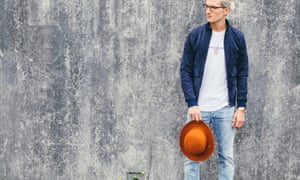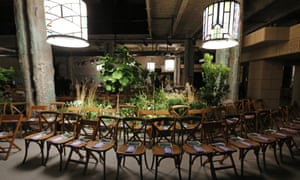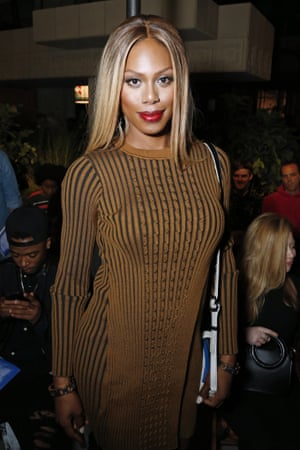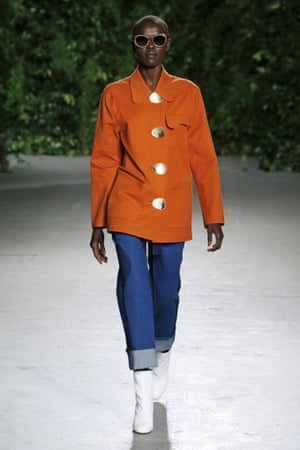TERRY GROSS, HOST:
This is FRESH AIR. I'm Terry Gross. My guest, designer Donna Karan, has dressed people like Barbara Streisand and Bill Clinton when he was president. Her clothes have been worn on many red carpets, but her clothes are also worn at work and on the weekends by people who buy off the rack at shopping malls. A recent New York Times article described Karan's idea of fashion as almost anti-elitist. She was recently described in Women's Wear Daily as one of the most important designers in the history of American fashion. Karan started off as a designer at Anne Klein's and became Anne Klein's assistant. She eventually became the company's chief designer. Karan started her own company in 1984. In '89, she started her more affordable casual brand DKNY. Over the summer, she stepped down from her role as chief designer at Donna Karan International. She's focusing on philanthropic work and her company Urban Zen. She has a new memoir called "My Journey."
Donna Karan, welcome to FRESH AIR. So what are some of the designs that you introduced that you feel had an effect on the fashion world?
DONNA KARAN: Oh, I guess the bodysuit - Seven Easy Pieces, a philosophy of dressing that I felt for women that needed to be on the go from the minute they got up in the morning till going to work, travelling...
GROSS: Explain what Seven Easy Pieces are.
KARAN: The Seven Easy Pieces was a philosophy that I had that if you had these seven pieces you were great to go. I almost took it from a point of view of having a piece of luggage and what would you pack if you traveled. And it started with the bodysuit, and the reason the bodysuit started is because my practice of yoga. So I was used to wearing a bodysuit and that's how I started my day. And then either a pair of pants or a skirt or top of some sort - a sweater. I always felt that a leather jacket was great and a coat. My favorite piece of all is a scarf.
GROSS: Why?
KARAN: 'Cause a scarf is one thing that - you can wrap it around, you can hide what you want to hide and show what you want to show and it's sort of like your partner in crime.
(LAUGHTER)
GROSS: So the thing about your Seven Easy Pieces is that you could travel, you have these seven pieces and they could get you through daytime, eveningwear. You could, like, you know, match things to suit the occasion of the day and you wouldn't have to travel with this big wardrobe.
KARAN: Exactly.
GROSS: Well, you mention the bodysuit. The bodysuit - it's like a one-piece thing that kind of snaps under the crotch, yes?
KARAN: It's sort of like a leotard. Well, it is like a leotard, but it's something that I wore every day. And the beauty of the bodysuit - it had all different neck lines, different arms. Some were sleeveless. Some were off the shoulder, turtlenecks, V-necks.
GROSS: You've had two really big lines under your name - the Donna Karan New York and DKNY. What were the differences between the two?
KARAN: Well, Donna Karan was a personal wardrobe for myself and my friends. I really never imagined that Donna Karan would grow to the size that it grew. But it was really after designing Anne Klein I decided I wanted to have a little collection - small little collection - for me and my friends of my Seven Easy Pieces, starting with the bodysuit. And then my daughter and all her friends started wearing all my clothes and I needed a pair of jeans - voila, DKNY.
GROSS: Because of the jeans or because of your daughter (laughter)?
KARAN: Well, it was a double situation. All her friends were borrowing all my clothes and I said this has got to stop (laughter). And I realized there was a larger market out there for what we were doing. But I wanted to create sort of the Seven Easy Pieces that I had done for collection but through a more him and a her point of view that we all needed a pair jeans. We needed an anorak jacket. We needed a T-shirt. I love jumpsuits - a blazer and a pair jeans.
GROSS: So what makes a great pair of fitting jeans since we all are shaped a little differently (laughter)? Like, what's great fitting for you might not be for me. Do you know what I mean? How do you make a great fitting pair of jeans that will fit women with different body sizes?
KARAN: Figure types.
GROSS: And figure types, exactly.
KARAN: Generally speaking, it's better to have it lower in the front and a little higher in the back...
GROSS: Yes.
KARAN: ...You know, for the curvature of the body.
GROSS: (Laughter) I agree.
KARAN: So then when you sit down it doesn't fall down in the back. And also where the crotch is created...
GROSS: Yes.
KARAN: ...It's better to have the crotch a little bit towards the front as opposed to the back. And then the cut of the legs - depending on what kind of leg that you want.
GROSS: You were born into fashion. Your mother was a model who later became a showroom salesperson. Your father, Gabby Faske, made custom suits. He died in a car accident when you were a child. Your stepfather was in the clothing business, too. You say he was on the cheap side of the street, selling knockoffs and schmahtas (ph). Looking back on your life as you do in your book - looking back you think that your mother was bipolar. What makes you think that?
KARAN: I'm not sure the word would be bipolar, but my mother was a very stressed-out lady. She had a lot on her plate. She was a working woman in those days, which is quite unusual. She had two children - myself and my sister Gail. And she loved working. You know, the woman who went to work was one thing and then the woman who came home from work was a little bit of another (laughter).
GROSS: More high strung after work?
KARAN: Well, she had a lot of migraines. She had to do a lot of work, you know, whether it was the laundry or, you know, making sure she was prepared to go to work. And, you know, in those days, she would go to the beauty parlor on Saturdays and make sure her hair was right for the rest of the week. So it wasn't really fun. It was more - rotated around, you know, preparation for her either tired from a weeks, you know, a week of work or getting ready for the week to come.
GROSS: So how did you know you wanted to be a designer?
KARAN: I didn't. I didn't want to be a designer. The last thing I wanted to do was work on Seventh Avenue. I wanted to be a singer like Barbara Streisand and I wanted to be a dancer like Martha Graham. I loved the body. I loved the movement of the body. But I was neither of them. However, what I decided that I thought I would like to do is be an illustrator. I love drawing. I love drawing bodies. I love drawing fashion, but I wasn't thinking of myself as a designer in those days. And then I went for a job at Women's Wear Daily and they said, you know, I think maybe you should look into design instead of illustration (laughter). I saw that I could not sing like Barbara and I couldn't dance like Martha so I was sort of put into the fashion industry. I started working in Sherry's clothing store when I was young and I love dressing people. I loved helping them find the right clothes. I liked working in retail store, arranging it and making it look really pretty, making it easier for the customer. So I found that I was getting into fashion whether I liked it or not (laughter).
Advertisment
Cheap Jordans from China Replica Basketball Shoes Best Replica Shoes Fake Branded Shoes Cheap Air Max Shoes
GROSS: You started your career working with Anne Klein. You became a designer there and Anne Klein got cancer - breast cancer. And you took on an increasing role when she was sick. You had your first child just before she died, and you had hoped to be a stay-at-home mother but instead the company called you and said we need you. You have to be here or you have to help take over. How did you weigh in your mind what to do at that point?
KARAN: It was such a state of shock for me. They called me as I was having my baby. And I said, would you like to know whether I had a boy or girl? By the way, it was a little girl. Her name is Gabby. And they said, well, Anne's in the hospital and we have a collection due. And I said, well, I asked my doctor. I said, when can I go back to work? And he says, you just had, you know, a 10-pound baby girl. You can't go back to work so fast. You know, you need at least a week. So they said, well, we'll bring the work to you. So we went to my home in Long Island where I had just moved in. And the entire company came to my house and I thought how great - bagels and lox and everything else and see my little baby Gabby. But as soon as that happened, the phone rang and Anne died. I had no idea she was as sick as she was. In those days, people really didn't discuss the disease of cancer, and it was a shock. And a collection was due the next day. Actually, they postponed it a day because of the funeral, but the following day the collection did open and that was pre-fall. And then I had to push up my sleeves and get fall done. It wasn't a question of really thinking this out. It's amazing to me how all of a sudden things happen the way they happen.
GROSS: So you became, like, the chief designer at Anne Klein. And what happened to your dream of being a stay-at-home mother? Why was that your dream, first of all?
KARAN: Coming from a working woman, I said I promised I would never go to work, or I'd never be a working mom because I had come from...
GROSS: Because your mother has paid so little attention to you.
KARAN: I had come from a working mom. Just that I realized how do you do it all? It's really quite hard. It's not an easy - you know, people ask me how do you do it today? And I'm saying it's not easy.
GROSS: And you saw how stressed out she was.
KARAN: Yeah, and I wanted to have the opportunity to stay home with my daughter, but I guess that's not what the universe had in mind for me.
GROSS: If you're just joining us, my guest is Donna Karan, the designer - the famous designer. She has a new memoir called "My Journey." Let's take a short break. Then we'll talk some more. This is FRESH AIR.
(SOUNDBITE OF MUSIC)
GROSS: This is FRESH AIR, and if you're just joining us, my guest is designer Donna Karan. She has a new memoir called "My Journey." I want to get back to Anne Klein for a moment.
KARAN: Sure.
GROSS: We talked about how her death from breast cancer affected your career and your plans - how it upended your plans to be a stay-at-home mother. But I'm sure you were also very close to her as a person. She had guided you through the early part of your career and given you really big breaks. I'm assuming she was probably the first colleague you were close to who you lost that way. What impact did it have on you, personally, her death? And to lose someone you were close to and know that, you know, that these things...
KARAN: Happen (laughter).
GROSS: Yeah, that these things happen, yeah.
KARAN: I was in a state of shock. Anne was like my mom - my second mom. We did everything together. We worked together. I spent the weekends together. She hadn't had any children, and it just kind of worked for both of us. And I think we were sort of the 24/7 working pair, if that makes any sense - that we'd work and play and kind of hang out together. I remember a lot of times hanging out at her beach house in Westhampton.
GROSS: Did that lead to any conflicts, being, you know, close friends and hanging out together in your off time as well as working together?
KARAN: I never felt that she was my friend as much as my mentor.
GROSS: You left Anne Klein, the company, in an unusual way. After she died, you were their chief designer for a while. They told you that your heart wasn't in the company anymore, and you had to leave. But they also told you if you wanted to start your own company, that they would be your business partners. Would you explain that exchange little bit?
KARAN: No, I was really surprised. I had this idea of starting a - as I said to you - a small little company for me and my friends, just seven easy pieces. I just wanted to design, really, a little company. So I figured I could do Anne Klein. I did Anne Klein, too. And I felt that was rather easy. But my bosses at the time felt that that wouldn't work. And they wanted a hundred percent, you know, attention put on Anne Klein, which I could understand now, believe me. And they said, you know, basically that I was fired (laughter). And I go, what? What do you mean I'm fired? And they said, you're fired, but we'll put you into business. And you could do Donna Karan. And I was kind of shocked by the whole thing, but I started Donna Karan right after working at Anne Klein for over 10 years.
GROSS: Did you see this as a compliment or an insult?
KARAN: Both.
GROSS: On one hand, they were throwing you out the door and the other hand, were saying, we're going to help you start your own company - your own brand.
KARAN: Exactly.
GROSS: Yeah.
KARAN: I don't think anybody had realized that Donna Karan would be the size company that it became, nor DKNY, for that matter.
GROSS: Well, your second husband, Stephan Weiss, who became your business partner, he -sounds like he really helped build the company on the business end.
KARAN: Well, he was kind of wonderful. He kind of kept my partners and everybody - all the stuff that I didn't want to deal with, Stephan dealt with. That was great (laughter). But Stephan was an artist, and I was really shocked by his genius at business. And he was the one who said that we should start a beauty company. So Stephan, in our own bedroom, would mix the products. He'd design the bottles. He mixed the product line and everything. And we started to become in the fragrance business that Stephan himself ran.
GROSS: There's a funny scene in the book where you wake up, and your husband has to go a business meeting. And he is wearing a brown plaid suit, a tan shirt and a wide tie.
And you...
KARAN: Oh, my God.
GROSS: ...Write that, like, you almost died looking at him. And you write, if anything could've made me fall out of love with Stephan, that was it. I felt like I'd woken up to a stranger, a man who bore no relationship to the sexy jeans-wearing guy I'd gone to bed with. Why was that suit so upsetting? (Laughter).
KARAN: It was really in your face. It was almost like a clown suit (laughter) is the only way that I could describe it, sort of this brown and beige plaid suit. And I had seen, you know, Stephan as a pair jeans and a little sexy sweater, top and stuff like that. And all of a sudden, I see him - wake up one morning, and I see him in this suit. And this is way before we got married.
GROSS: Oh, uh huh...
KARAN: This is when we first met him.
GROSS: OK. (Laughter).
KARAN: So I was at Parsons School of Design, and there he was, you know, being the antithesis of everything that I would not want to be with it all.
GROSS: (Laughter). So how somebody dressed was very important to you 'cause that was your thing.
KARAN: Well, I'm a very visceral person. So it's what I see, what I feel, what I touch, what I smell. All of these, you know, senses are very, very heightened as a designer. So, yeah, what I see I have - has an effect on me (laughter).
GROSS: Did you start dressing him after that?
KARAN: Yeah.
GROSS: (Laughter).
KARAN: He looked much better in Giorgio Armani.
GROSS: (Laughter).
If you're just joining us, my guest is designer Donna Karan. She has a new memoir called "My Journey."
Your husband died of lung cancer in 2001. And before he died, he sold your company so that you wouldn't have to worry about the business end of things and so that the family would have financial security after he was gone. So that meant this huge change in your life, both professionally and personally. You no longer owned your company, and you no longer had your husband. What did you do to survive that period?
KARAN: What I will I say...
GROSS: Oh, should we throw in that 9/11 happened just a couple of months after your husband died? And you lived in Manhattan and worked in Manhattan.
KARAN: After Steve passed, I felt very alone. I felt, you know - how was I going to do this without him? And I had a collection due that was coming up in September. And at that time, 9/11 had happened. And that was - our anniversary was that day...
GROSS: Your anniversary was September 11?
KARAN: Our anniversary's September 11. So the night before, I couldn't go to sleep. I figured - how am I going to do a show? My husband's not going to be there, and it's our anniversary. So I wanted to take a piece of his sculpture, which was a very large piece of sculpture and have it sit at - I was showing at the Armory at the time. So I asked somebody to please deliver one of my husband's pieces, so at least I'd feel that - he had a wire sculpture with a man sitting in a chair. And I thought that would be very cool, of having that, because the collection was very much inspired by him, and it had a lot of wiring.
But then I got a call that morning. I got woken up. I hadn't slept the night before. And somebody said to me, Donna, life will never be the same. And we were living down on Wooster Street. And I looked outside the window, and I saw what was happening, you know, on TV. It was September 11, and they had just hit the trade center. And Patti Cohen, who was in charge of PR and public relations, called and said, don't worry, Donna, the show's going on. And I said, that's the most ridiculous thing I ever heard of. You know, we have a catastrophe on our hands here right now. I can't imagine, you know, doing shows. She said, well, uptown seemed OK. And then the second plane hit. And then, all of a sudden, you know, the city was in complete, utter panic.
But the show did not go on. And what we did was - they had called us and said, could we use your armory as a holding ground because we felt all the hospitals would be completely jammed up? I said, absolutely, do whatever you need to do. And, unfortunately, nobody got to be at the armory, and even in the hospitals, you know. People hadn't made it.
GROSS: There wasn't that many people to rescue because they were killed.
KARAN: That's correct.
GROSS: You've left your company as of July. Why did you leave?
KARAN: It was a very difficult question. I don't ever feel like I left the company because I feel that the company is there (laughter). But I did realize - and I had been struggling for over past few years is - when I started Urban Zen, I was doing Urban Zen. I was doing Donna Karan. I was doing DKNY. And that was an awful lot to design and be the mother and the grandmother and all of that and the woman who was traveling all over the world. I said there are only X amount of hours in the day, and to do anything right, you know, I had maybe had taken on too much, you know, at this stage of life that I'm at. I had a future that I was getting older, and I wanted to say, you know - how did I want to spend the next 10 years of my life?
GROSS: And it still feels like the right decision?
KARAN: Now, I'm going through a little bit more difficult process. You know, it is a transition that I'm going through. There's no question that I know that I'm doing the right thing. But I still, you know, come September when the shows were going on, I'm going, oh, my God. I don't have to do a show.
GROSS: Donna Karan, thank you so much for talking with us.
KARAN: My pleasure.
GROSS: Donna Karan has written a new memoir called "My Journey." After we take a short break, Berkeley Breathed will tell us why he's returned after a long break and restarted his popular comic strip, "Bloom County." I'm Terry Gross, and this is FRESH AIR.





































